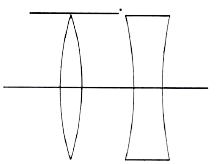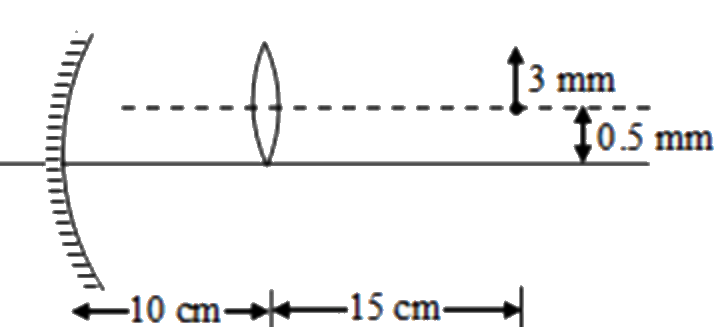A convex lens and a concave lens, each of focal length 10 cm, are kept separated by a distance of 2 cm as shown in the figure. If the light is incident from left, the combination of lenses will be :

converging
diverging
behaving like a glass slab
converging or diverging depending on whether the lenes are arranged as shwon in the figure on in the reverse order.
The correct Answer is:A
We know that the , focal leght of combination of lenses,
As 1f=1f1+1f2−df1f2
It is given that focal length of convex lens, f1=10cm
It is given that focal length of concave lens f2=−10cm
distance between lenses, d = 2 cm
Then, focal lenght of the combination .f. will be given by.
1f=110−110+2100
1f=2100=150⇒f=50cm
f = + 50 cm (converging lens)
Similar Questions
If a convex lens of focal length 10 cm and a concave lens of focal length 50 cm are kept in contact with each other , (i) what will be the focal length of the combination ? (ii) What will be the power of the combination? (iii) What will be the behaviour of the combination ( behaviour as a convex lens / concave lens ) ?
View SolutionA concave mirror of focal length 20 cm and a convex lens of focal length 10 cm are kept with their optic axes parallel but separated by 0.5 mm as shown in the figure. The distance between the the lens and mirror in 10 cm. An object of height 3 mm is placed on the optic axis of lens at a distance between the lens and mirror is 10 cm. An object of height 3 mm is placed on the optic axis of lens at a distance 15 cm from the lens. Find the length of the image formed the mirror in mm.
 View Solution
View Solution
Knowledge Check
- Question 1 - Select One
A convex lens of focal length 25cm and a concave lens of focal length 20cm are mounted coaxially separated by a distance dcm . If the power of the combination is zero, d is equal to
A45B30C15D5 - Question 2 - Select One
A convex lens and a concave lens are kept separated by a distance d. If they are placed in close contact, the focal length of the combination
Awill become zeroBwill increaseCwill decreaseDwill remain constant - Question 3 - Select One
If the optic axis of convex and concave lenses are separated by a distance 5mm as shown in the figure. Find the coordinate of the final image formed by the combination if parallel beam of light is incident on lens. Origin is at the optical centre of convex lens
 A(25cm,0.5cm)B(25cm,0.25cm)C(25cm,−0.5cm)D(25cm,−2.5cm)
A(25cm,0.5cm)B(25cm,0.25cm)C(25cm,−0.5cm)D(25cm,−2.5cm)
A concave and convex lens each of focal length 15 cm are kept 5 cm apart. An object is placed in front of the convex lens at a distance of 60 cm. Determine the position of final image.
View SolutionIf a convex lens of focal length 20 cm and a concave lens of focal length 30 cm are kept in contract with each other.
What will the power of the combination ?View SolutionA convex lens of focal length 10cm and concave lens of focal length 20cm are kept 5cm apart. The focal length of the equivalent lens is
View SolutionA convex lens of focal length 100 cm and a concave lens of focal length 10 cm are placed coaxialiy at a separation of 90 cm. If a parallel beam of light is incident on convex lens, then after passing through the two lenses the beam
View SolutionA convex lens and a concave lens, each having same focal length of 25cm, are put in contact to form a combination of lenses. The power in diopters of the combination is
View Solution

